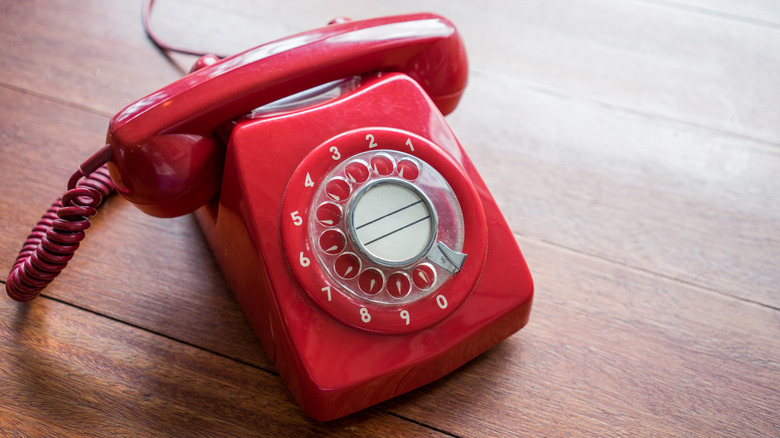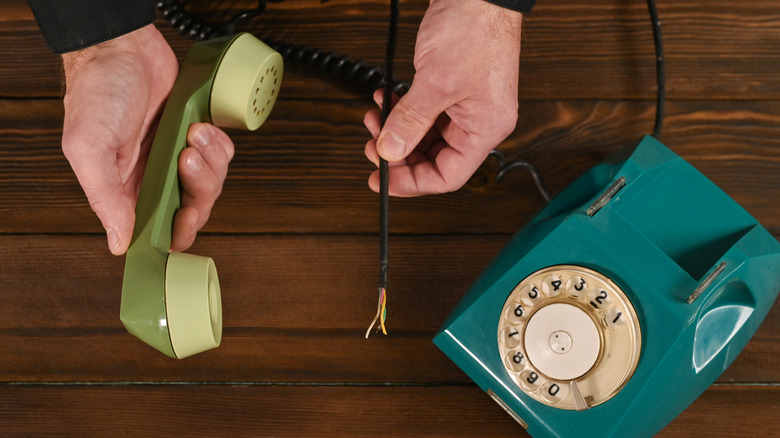Reuse An Outdated Home Phone With This Bright DIY Idea
We may receive a commission on purchases made from links.
There are two things we can pretty much universally agree on: Landline phones are not very useful anymore, but retro and vintage phones are oh so cool. This paradox creates an interesting conundrum: How can we make old-school phones into décor without feeling like there are too many superfluous knick-knacks all around? If you've got extra home phones laying around and collecting dust, you can put them to use with a simple hack that turns a colorful phone of yore into a lamp that elevates your décor and (quite literally) lights up a room.
Retro trends are making a comeback in 2025, and that includes vintage phones, which spark nostalgia and remind us of a time before everyone had the entire world on a small device in their pocket. Although many might see a colorful telephone and associate it with the 1980s or even the 1990s, these familiar phones actually date back to 1954, when Western Electric debuted colorful phones to replace the dark ones that preceded them. Early models of colorful home phones came in beiges, greens, and reds, but as the years went on, they got much more colorful and outlandish, going as far as see-through telephone sets that were everywhere in the '90s. Whether your salvaged landline is vibrant or demure, you can make it into décor with the following steps.
How to craft a telephone lamp
There are a few ways to accomplish the hack of upcycling an old landline phone into a décor-friendly lamp. All ways lead back to the same final result of having light bulbs in the handheld part of the phone that would typically be used as an earpiece and microphone. As such, you should start by unscrewing or popping off the caps that have the microphone and speaker holes in them. You should also remove the wires from the base unit of the phone, stripping it down to only the essential aesthetic parts. From there, you can drill holes in the phone caps that the light bulbs will eventually go into.
Next, remove the cord from the phone and twirl it around a curved, hollow metal rod, then string electrical wire through the rod. You can use a pivot joint at the base of the rod to connect it to the phone's handheld piece in a way that will create the perfect lamp angle. Wire in the light bulb sockets — making sure that you're adhering to safety precautions and avoiding dangerous mistakes in DIY electrical projects — and then reattach the caps and screw the light bulbs into place. Finally, connect the wiring (that's already in the metal rod and through the phone cord) into the base of the phone. Use twist-on wire connectors to complete the connection of the cords so that electricity can easily flow through, and then you're ready to light up your new, retro lamp!
How to do this craft without wiring
Does working with wires give you a headache? Even though the above crafting method is safe to do because the wires aren't plugged in while you're putting the lamp together, it's still not a particularly easy method for anyone who's never worked with electrical wiring before. You can save yourself some time by using a cordless wall lighting idea instead, which will get you a similar (although perhaps less professional-looking) result for your converted phone lamp.
Similar to the first version of this craft, you should begin by taking the circular speaker frames out from the ends of the handheld part of the phone and clearing anything behind them. Then, instead of wiring a lightbulb through the hollow phone parts, you can find a wireless light bulb that fits into your base. Consider buying something like the Brightown rechargeable light bulbs, which detach from their base to recharge. You can use hot glue to affix the base of the bulbs into either end of the phone's handheld part and then use the remote to turn them on and off (wait for the glue to dry fully before turning the lights on). From there, you can place the base of the phone anywhere in your home. Consider trapping the cord and handheld piece around a makeshift trellis, like some thin PVC pipe, so that you get some good height for the light to emanate from.

